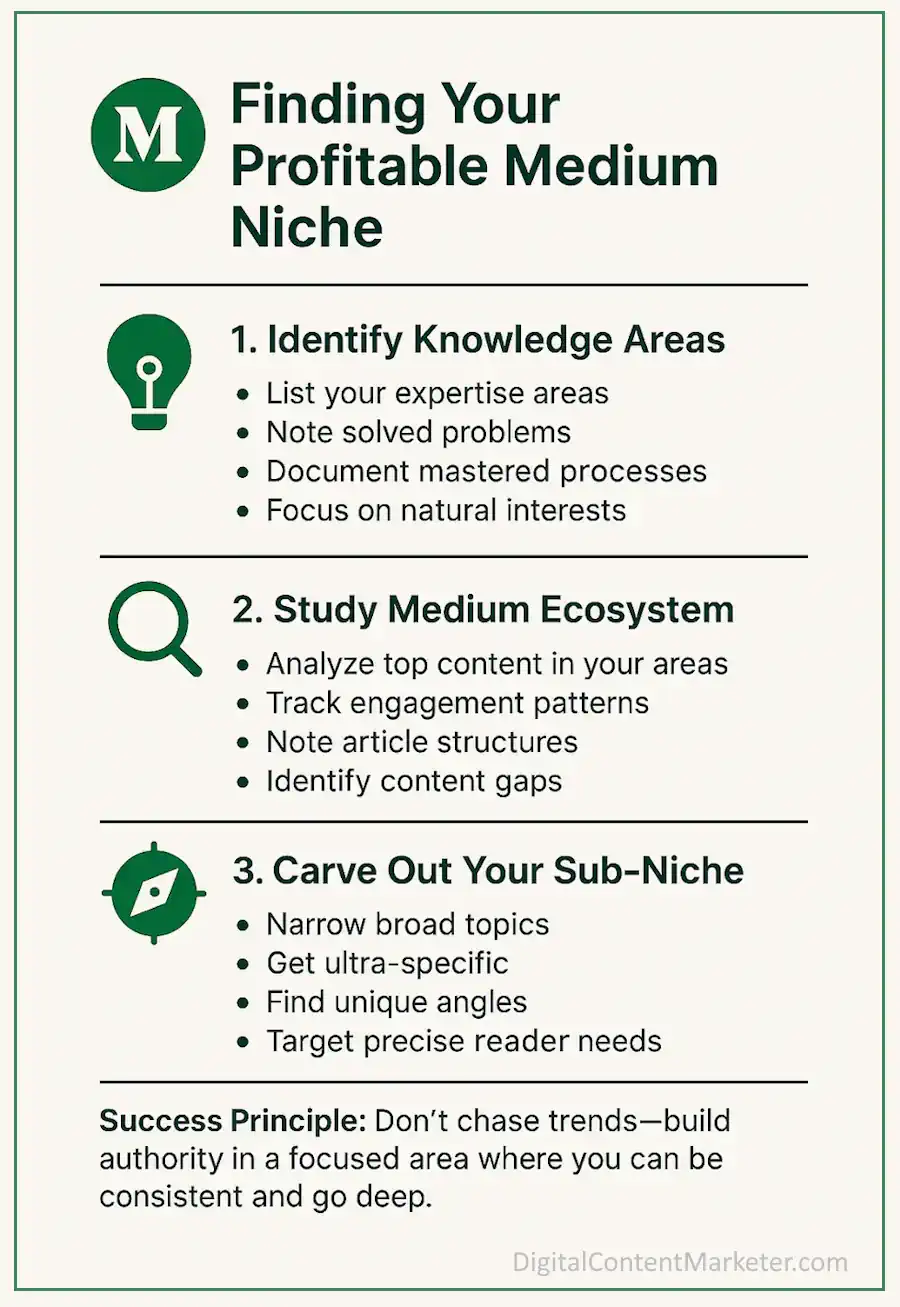Finding Your Focus
Before you write a single word on Medium, you need to know who you’re writing for and what kind of content can actually make you money. Medium isn’t about writing whatever’s on your mind and hoping it catches fire.

It’s a content marketplace disguised as a writing platform. Readers vote with their attention. Some niches get more traction, more engagement, and more earning potential than others.
If your goal is to turn words into revenue or leads, choosing the right niche is the most important decision you’ll make. The good news is that there are plenty of profitable ones. You just need to know where to look—and how to position yourself once you find your lane.
Business and Entrepreneurship: High Competition, High Reward
Business and entrepreneurship are among the most saturated but also most rewarding categories on Medium. Readers on this platform aren’t just curious. They’re searching for answers.
People come here to learn how to start businesses, grow side hustles, scale revenue, and streamline systems. Articles about startup strategies do especially well when they include personal experience, transparent numbers, or a new spin on common advice.
Readers want insight they can’t find in dry textbook posts. If you’ve bootstrapped a business, pivoted through failure, or grown something on a shoestring, you’re already sitting on valuable content.
Marketing: A Goldmine for Practical Content
Marketing—especially digital, content, and social media marketing—is another goldmine. This is a space filled with freelancers, agency owners, bloggers, and small business operators looking for strategies that work.
Tutorials on content planning, automation, email funnels, or social growth tend to pull strong engagement, particularly when they walk readers through real examples. There’s room here for both tactical guides and opinion-based pieces, as long as the writing stays useful.
If you’re already using tools like ChatGPT, Jasper, or Notion in your marketing workflow, documenting that process turns it into easy, high-impact articles.

Finance and Investing: Practical Over Speculative
Finance and investing have always attracted readers, but Medium’s audience leans toward practical, everyday strategies rather than high-risk speculation.
You don’t need to write about crypto or hedge funds to find success here. Topics like budgeting, building multiple income streams, investing for beginners, and managing freelancer cash flow often outperform flashy content because they speak to people’s actual needs.
If you’ve figured out how to balance business expenses, save on taxes, or track your profits, you’re already a step ahead of most writers who are trying to wing it.
Productivity: Universal Appeal Across Niches
Productivity and efficiency content consistently pulls readers across multiple niches. Medium is full of people trying to do more with less. Articles about time management, digital tools, deep work, and daily habits perform well when they offer systems people can test right away.
You don’t need to be a life coach or productivity guru. You just need to show what’s working for you and explain it clearly. The more concrete your advice, the better. People love templates, checklists, workflows, and “here’s exactly how I did it” breakdowns.
Technology and AI: Exploding Opportunity
Technology and AI are exploding right now, and that trend isn’t slowing down. Writers who can break down technical topics into plain English have a major advantage. You don’t need to be an engineer or coder.
If you can explain how non-tech people can use AI in their daily workflow—especially for marketing, productivity, or creative work—you’ll find an eager audience. Medium readers are especially drawn to pieces that explore the intersection of AI and business, side hustles, or personal efficiency.
There’s also growing interest in tools and platforms built with AI, especially if you’re showing how to use them rather than just reviewing features.
Personal Development: Quality Over Clichés
Personal development is a wide field, but it thrives on Medium because it blends easily with other niches. Articles about mindset, resilience, focus, self-discipline, and confidence all perform well when they feel grounded in real experience. People are burned out on cliché self-help advice.
What they want are real stories, practical tips, and unexpected truths that feel personal but are still relevant. If you’ve figured out how to build habits, handle setbacks, or work through impostor syndrome, there’s an audience for your insights.

Remote Work and the Future of Work
Remote work and the future of work is another hot niche, especially among digital nomads, freelancers, and anyone trying to escape traditional office life. Medium readers want advice on how to land remote jobs, build structure in their day, or navigate hybrid careers.
Content about online tools, team communication, and digital collaboration fits right in. If you’ve successfully built a location-independent business or have insights into hiring and managing remote workers, this is a solid space to claim.
Micro-Niches: The Untapped Sweet Spots
Beyond the main categories, there are other niche topics that quietly perform very well. Parenting as an entrepreneur, digital decluttering, creative burnout recovery, tech minimalism, and solopreneur mental health are all examples of sub-niches with loyal readers and relatively low competition.
These types of topics often sit at the intersection of two popular areas, like productivity and wellness, or tech and lifestyle. When you find a crossroad like that, you open up new angles that haven’t been picked over yet.
Finding Your Profitable Niche: A Strategic Approach
The key to finding a profitable niche isn’t chasing what’s trending. It’s choosing a topic where you can go deep, show authority, and stay consistent.
Step 1: Identify Your Knowledge Areas
Start by narrowing down the categories you naturally write about or think about most often. What expertise do you already have? What problems have you solved? What processes have you mastered?
Step 2: Study the Medium Ecosystem
Look at what’s already being published on Medium in those spaces. Pay attention to article views, engagement levels, and how often the same writers get featured. Don’t just study the top-performing stories.
Look for patterns. What voice do they use? What structure? How long are the articles? What kind of visuals, if any, do they include?
Step 3: Carve Out Your Sub-Niche
Once you’ve narrowed down a category, start carving out your sub-niche. This is where you create separation. Instead of trying to write about “marketing,” get specific. Are you focusing on affiliate marketing for creators? Email strategy for service providers? Content marketing using AI tools?
The more focused your content is, the more likely it is to get traction. Broad topics get drowned out. Narrow topics attract the right readers who stick around and share your work.

Using Medium’s Tools to Analyze Competition
You can also use Medium’s own search and tag tools to analyze competition. When you type a keyword into the search bar, Medium shows related tags and how many people are writing under each one.
Tags with thousands of writers might seem appealing, but they’re often oversaturated. Instead, look for tags that have a decent readership but fewer competing voices. These are the sweet spots where your content is more likely to rise to the top.
Mining Publications for Niche Opportunities
Another way to gauge potential is by checking existing publications in your niche. Publications are curated collections of content, and most have open submission guidelines.
See what kinds of articles they publish, how often, and which ones get featured. If you notice a gap—topics they haven’t covered or angles they’re missing—you’ve found an opening. These are great places to pitch once you’ve written something tailored to their audience.
Testing Multiple Niches: The 3×3 Approach
Still struggling to choose a niche? Try the 3×3 approach:
- Identify three potential niches that interest you
- Write three articles in each niche
- Track performance metrics for each piece
- After nine articles, evaluate which niche generated the most:
- Reads and read ratio
- Follower growth
- Comments and engagement
- External clicks (if you included links)
This systematic approach lets you test the market before fully committing to a niche, saving you from investing months in an area with limited potential.
Combining Expertise with Market Demand
The most profitable Medium niches sit at the intersection of what you know well and what readers actively seek. You don’t need to chase trends that you have no connection to—instead, look for ways to apply your existing knowledge to evolving interests.
For example, if you have years of experience in customer service but notice that AI customer service tools are trending, you have a unique angle: how traditional customer service principles apply to AI implementation.
Finding Your Medium Sweet Spot
Here are some examples of finding your content sweet spot by identifying the intersection between your knowledge and readers’ interests, just to get you thinking:
Example 1
- What I Know: Finance & Investing
- What Readers Want: Personal budget help
- Sweet Spot: “5-Minute Budget Fixes for Young Professionals”
Example 2
- What I Know: Web Design
- What Readers Want: AI tools for beginners
- Sweet Spot: “Using AI to Create Professional Website Images Without Design Skills”
Example 3
- What I Know: Productivity Systems
- What Readers Want: Work-from-Home Focus
- Sweet Spot: “Notion Templates for Remote Workers with ADHD”
Example 4
- What I Know: Content Marketing
- What Readers Want: ChatGPT Applications
- Sweet Spot: “Training ChatGPT to Write Your Email Newsletter”
Example 5
- What I Know: Health & Nutrition
- What Readers Want: Quick meal solutions
- Sweet Spot: “15-Minute Anti-Inflammatory Meals for Busy Entrepreneurs”
Example 6
- What I Know: Software Development
- What Readers Want: No-Code Solutions
- Sweet Spot: “Building SaaS Products Without Coding: A Developer’s Guide to No-Code”
These examples show how specificity at the intersection of your expertise and reader needs creates a compelling content niche that’s more likely to gain traction on Medium.

Ultimately, a profitable niche on Medium is one where you can add value consistently. If you can solve real problems, share practical strategies, and speak with clarity, you don’t need to be the loudest voice. You just need to be the one that people come back to.
Focus on building trust with your audience, and the profits will follow. Pick your niche with care, not urgency. This isn’t about what’s hot. It’s about what you can own.
You just finished part 5 of our Medium monetization series. Next in our series: Medium Content That Works: Engagement Strategies for Writers – Learn how to create content that captivates Medium readers and drives real engagement. Or return to the intro and the full series’ Table of Contents.

